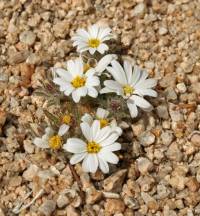Annuals, 1-5 cm, herbage hispido-hirsute (hairs long, white), minutely glandular; taprooted. Stems prostrate to decumbent (radiating from base), simple or branched. Leaves basal and cauline; alternate; petiolate; blades 1-nerved, oblong to oblanceolate-spatulate, margins entire (apices rounded to obtuse). Heads radiate, borne singly (usually immediately subtended and surrounded by distal leaves). Involucres campanulate, 4-6 × 6-7 mm. Phyllaries 10-14 in 1(-2) series, appressed (purple-tipped), 1-nerved (midnerves raised-indurate, evident only in proximal 1 / 2 ; proximally convex, not keeled), linear-lanceolate, equal, margins herbaceous or scarious, faces hirsute. Receptacles flat, pitted, epaleate. Ray florets 12-21, pistillate, fertile; corollas white or rose- or purple-tinged (strongly coiling). Disc florets 28-40, bisexual, fertile; corollas yellow (with prominent orange veins), tubes much shorter than narrowly tubular-funnelform, lobes 5, reflexed, lanceolate; style-branch appendages obtuse to truncate. Cypselae (brownish) obovoid, compressed, 2-ribbed, faces sparsely strigose; pappi persistent, in (1-)2 series, short-toothed cups plus 1 apically plumose bristle or 8-15 inner, tawny white, barbellate, apically attenuate bristles plus outer of short, laciniate paleae. x = 8.
Both species of Monoptilon are decumbent to prostrate, hispid annuals with campanulate involucres, white coiling rays, obovoid compressed cypselae, and chromosome number of 2n = 16. The genus was placed by G. L. Nesom (1994) as sister to Chaetopappa.





